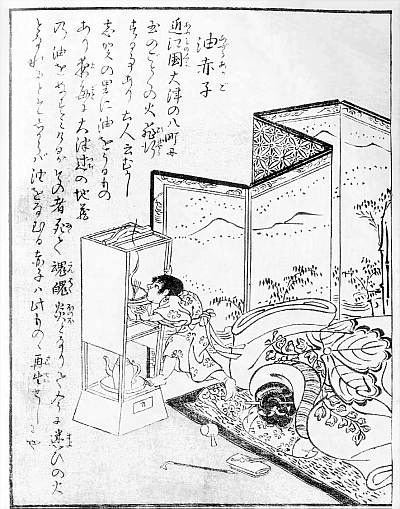 | ||
Abura-akago (油赤子, "oil baby") is a Japanese yōkai that appeared illustrated in Toriyama Sekien's mid-Edo period Konjaku Gazu Zoku Hyakki, as an infant spirit lapping oil out of an andon lamp.
Sekien's accompanying notes describe it:
In the eighth town of Ōtsu in Ōmi ("Afumi") Province there exists a flying ball-like fire. (近江国 (あふみのくに) 大津の八町に玉のごとくの火飛行 (ひぎやう) する事あり。)The natives say that long ago in the village of Shiga there was an oil merchant, and every night he stole the oil from the Jizō of the Ōtsu crossroads, but when this person died his soul became a flame and even now they grow accustomed to this errant fire. (土人云、むかし志賀の里に油をうるものあり、夜毎に大津辻の地蔵の油をぬすみけるが、その者死て魂魄炎となりて今に迷ひの火となれるとぞ。)If it is so then the baby which licks the oil is this person's rebirth. (しからば油をなむる赤子は此ものの再生せしにや。)The words after "long ago in the village of Shiga" were quoted from a story about a mysterious fire called the "abura-nusumi no hi" (the oil-stealing fire), which featured in the Edo period books, the Shokoku Rijin Dan (諸国里人談) and the Honchō Koji Innen Shū (本朝故事因縁集). In those books, it's stated that there was a folk belief where an oil merchant from Ōtsu, Ōmi Province steals oil from a Jizō statue at the crossroads so that he can sell them, and became lost and turned into a mysterious fire after death. In Mount Hiei, it's said that a mysterious fire called the abura-bō appears, and in the Shokoku Rijin Dan, this fire is seen to be the same as the "abura-nusumi no hi." It's inferred that Sekien's abura-akago was a made-up tale based on this "abura-nusumi no hi" in the Shokoku Rijin Dan and other books.
In more modern yōkai literature, it's interpreted that this yōkai takes on the appearance of a ball of flames and flies into people's houses, shapeshifts into that of a baby and licks the lanterns (andon lanterns), and returns to being a ball of fire and leaves. There's the theory that in the countryside in the past, unrefined materials like fish oil were used, so when cats licked the lamps, they might have looked like an abura-akago (baby licking an oil lamp).
Resembling this interpretation, in the book Tōhoku Kaidan no Tabi by the novelist Yamada Norio, a collection of kaidan, there was one Akita Prefecture kaidan titled "abura-name akago" (oil-licking baby) in which a baby-carrying woman in Akida stayed at the house of a shōya, and there the baby sucked completely dry all the oil of a lantern. Specialists have pointed out that Tōhoku Kaidan no Tabi includes many Sekien-created yōkai that have not originated from folklore, leading to the theory that this "abura-name akago" was also created based on Sekien's abura-akago. In Ihara Saikaku's early Edo period ukiyo book the Honchō Nijū Fukō (本朝二十不孝), an oil lantern-drinking baby also appears, but it's also been noted to be something made up.
Like the abura-nase and the ubagabi, there are many yōkai legends related to an attachment to oil. In this background, oil was a valuable resource used as food and as illumination in Japan, becoming even more of a necessity since the middle ages due to an improvement in refining technology, leading to the theory that these yōkai were born as a warning against wasting oil by licking and sucking it.
